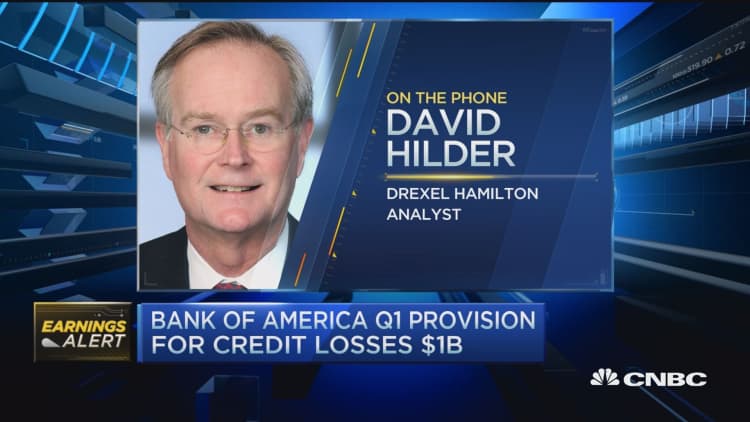
Bank of America, the No. 2 U.S. bank by assets, reported an 18 percent slide in quarterly profit as concerns about a global economic slowdown and uncertainty about the pace of U.S. interest rate increases dampened bond and stock trading.
The profit was in line with low expectations after what was widely being seen as the grimmest quarter for the banking industry since the 2007-08 financial crisis.
Market volatility stemming from a slide in commodity and oil prices, worries about China's economy and uncertainty about interest rates hit trading activity globally in the quarter, particularly in January and February.
Net income attributable to common shareholders fell to $2.22 billion, or 21 cents per share, in the three months ended March 31, from $2.72 billion, or 25 cents per share, a year earlier.
Revenue for the quarter came in at $20.9 billion, against the comparable year-ago figure of $21.42 billion.
Analysts had expected to report earnings of about 20 cents a share on $20.3 billion in revenue, according to a consensus estimate from Thomson Reuters.
Adjusted revenue from bond, currency and commodities trading (FICC) fell 17.5 percent to $2.26 billion in the quarter, while total revenue fell 6.6 percent to $19.73 billion.
BofA's shares, which fell 20 percent in the quarter, were down 1.4 percent in premarket trading after rising 3.9 percent on Wednesday following better-than-expected earnings from JPMorgan, the biggest U.S bank.
JPMorgan, whose results had helped to allay some concerns about the quarter for U.S. banks, reported a 13.4 percent decline in bond trading revenue.
BofA, one of the biggest U.S. lenders to the oil and gas industry, said total provisions rose 30 percent to $997 million in the quarter, largely due to potential losses on energy loans.
Overall credit quality remained strong, the bank said, while consumer portfolios continued to improve and commercial portfolios remained stable except in the energy sector.
A report by Barclays estimated that 2.3 percent of BofA's total loans were energy-related at the end of December.
BofA's non-interest expenses fell 6.4 percent to $14.82 billion, mainly due to a 28 percent drop in costs in its legacy assets and servicing unit, home to many bad loans inherited from its 2008 purchase of subprime lender Countrywide Financial.
BofA — which has been slower than its rivals to recover from the financial crisis because of problems linked to Countrywide — as been slashing billions of dollars in costs in its commercial lending, investment banking and wealth management businesses to try to make up for sluggish revenue growth.
While Bank of America has shown some progress, it still has to prove it can generate consistent performance under Chief Executive Brian Moynihan, who took the helm in 2010.
During his tenure, the bank has paid tens of billions of dollars in fines and settlements related to mortgages that were issued before he became CEO.
Adding to his problems, regulators said on Wednesday that BofA could face stricter regulations and capital requirement limits if it did not correct deficiencies in its plans for a bankruptcy that did not rely on taxpayer money.
Last month, Bank of America's board of directors increased its stock repurchase up to $800 million. The board had originally approved a $4 billion buyback earlier in March.
The U.S. bank also reportedly made a big push into auto lending despite warning signals from regulators as auto loan losses rise. Bank of America said that it still saw room for expansion from customers with good credit.
— Reuters and CNBC's Christine Wang contributed to this report.



